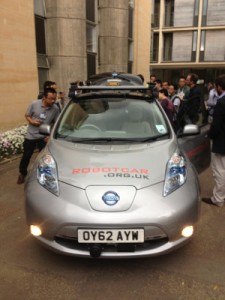Oxford’s mobile robotics group has been making rapid progress in the development of driverless cars. As Prof. Paul Newmann explained in a lively lecture last Thursday (as part of the 14th Annual Robotics Systems Conference), it took his group of 20 PhD students just 4 months to build an autonomous car that was able to navigate local streets.

Prototype Autonomous Car (Photo: Hars, 2013)
While being equipped with some algorithms for obstacle detection, the car primarily serves as a test bed for advanced navigation algorithms. Similar to Google, the group uses prior knowledge about the roads to be traveled, but their algorithms can work with much simpler and much less expensive sensors. The car does not need 3D LIDAR sensors. It uses a much cheaper 2D Lidar which is affixed to the very front of the vehicle. The rotating laser captures a slice of points with distance information in a single line below the car as well to the right and the left of the car. As the car moves forward and scans line after line a 3D picture gradually emerges. The car determines its position by comparing the data points gathered to its prior knowledge. The sensor can capture about 40 lines per second. This works well for low speeds but would have to be increased for higher velocities.
Prof. Newmann has also come up with a new approach for navigating in snow and rain. Localization can be very difficult when snow changes the environment’s appearance. His solution is only seemingly simple: instead of trying to detect invariant properties of the landscape, he proposes to accept that the environment may have multiple appearances. Thus he adds the different ways that the environment may look to his store of prior knowledge. As the car drives a known area, it identifies that prior view (winter, summer..) which most closely matches the data captured by its sensors and uses it for localization. It will be interesting to see how robust this approach of “experience-based navigation” can be and how many variations of the environment will be needed to allow fully autonomous driving.
The group currently has two driverless car prototypes; one of them is part of a cooperation with Nissan. It will be interesting to see whether Nissan will incorporate some of the groups navigation algorithms into their solution.
